Introduction
This is a common refrain among Netflix critics: “Films released on Netflix sink to the depths of the catalog a week after their release, never to be heard of again—no one watches them!”
For the past two years, Netflix has been publishing its Engagement Reports every six months, detailing the viewership for over 18,000 titles each semester across the globe, 99% of everything that’s watched globally on Netflix. This provides ample data to answer the question of a film's long-tail viewership months and even years after its release on Netflix.
Methodology
To establish the list of eligible films, I chose to focus on American films that were available worldwide on Netflix and released before December 31, 2021.
Why only American films? Because they are inherently the most well-known and are often at the center of these criticisms, especially when renowned filmmakers decide to make their next film with Netflix. Of course, these films also tend to be the most-watched, so keep in mind that the figures presented here are naturally higher than those for international films—but that makes sense. However as you’ll see, we also go right to the bottom of the Engagement Reports with some films so we have a pretty good overview of the whole range of viewership.
Why only globally available films? Because titles that are Netflix films in only certain countries have lower viewership numbers by default. Moreover, these films may arrive in some other countries long after their initial release elsewhere, artificially inflating their total viewership figures over time.
Why films released before December 31, 2021? Because the goal of this study is to analyze the long-tail performance of Netflix films, and waiting at least a year after a film’s release seems like a reasonable threshold for assessing long-term viewership.
I then divided the total viewing hours reported by Netflix in each of its Engagement Reports—covering the first half of 2023, the second half of 2023, the first half of 2024, and the second half of 2024—by the films’ runtimes. This gave me a measure in Completed Viewings Equivalent (CVEs), which I use in all my analyses to place all films on an equal footing.
General Overview
A total of 276 American Netflix Original films meet the criteria set for this study, providing a substantial sample for analysis. Let's start with a general overview: these 276 American films released before 2022 accumulated approximately 3,842,300,000 complete viewings over two years—three billion, eight hundred forty-two million, three hundred thousand viewings in 729 days.
I say “approximately” because some of these films no longer appeared in the Engagement Reports, meaning they had fewer than 100,000 viewings per semester. Fewer than 100,000 does not mean zero but this is negligible in the grand scheme of things. That still leaves 3.8 billion complete viewings, which breaks down to 5.27 million per day, 220,000 per hour, or 3,660 per minute, sustained over two years for these “old” American Netflix films.
It's hard to grasp just how massive and significant this long-tail viewership is, but one thing is clear: no, Netflix’s older films are not hidden by the algorithm or buried deep in the catalog, never to be watched again.
That said, it is still a long tail, meaning there is a natural decline. Of the 276 films analyzed, 143 experienced a steady decline in viewership across each semester of 2023 and 2024—an average drop of 33% per period. This steady decline eventually causes some films to disappear from the Engagement Reports altogether, as they fall below the 100,000 EVCs threshold per semester.
By the second half of 2024, 14 of the 276 films had dropped off the Engagement Report, representing 5.1% of the dataset.
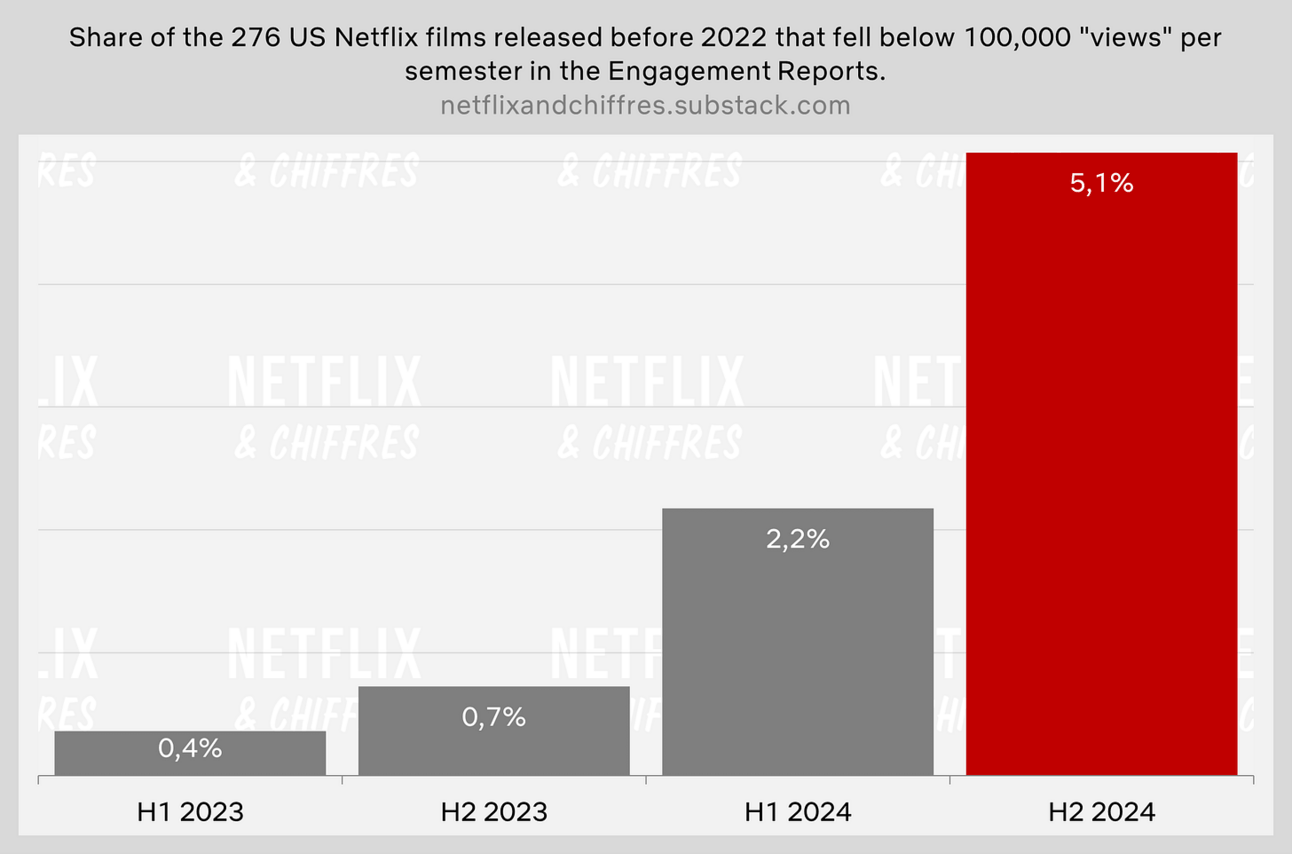
Among the 14 films from the 2015–2021 period that were absent from the Engagement Report in the second half of 2024, the most recent one was Mank, released in December 2020. David Fincher’s black-and-white biopic about a 1940s filmmaker was never the most commercially appealing title, despite its prestigious director.
Black-and-white films, in general, don’t perform well on Netflix, making Mank’s disappearance less surprising.

According to my observations, only one American Netflix Original film released before 2022 never appeared in any of the four Engagement Reports from 2023 and 2024: Tigertail, directed by Alan Yang and released in April 2020. The film tells the story of a Taiwanese immigrant in the United States reflecting on his life.
My suspicion is that Tigertail is viewed more as an Asian film than an American one, which may explain its lower visibility in the Engagement Reports. Internationally, a much larger number of films have fallen below the reporting threshold.
The 40 American Netflix Films Released Before 2022 That Were The Most-Watched in 2023 and 2024.
Rather than focusing on films that never made it into the Engagement Reports, let's look at those that did—and did so impressively. Here’s the Top 40 ranking of the most-watched American Netflix films released before 2022 during the 2023–2024 period.
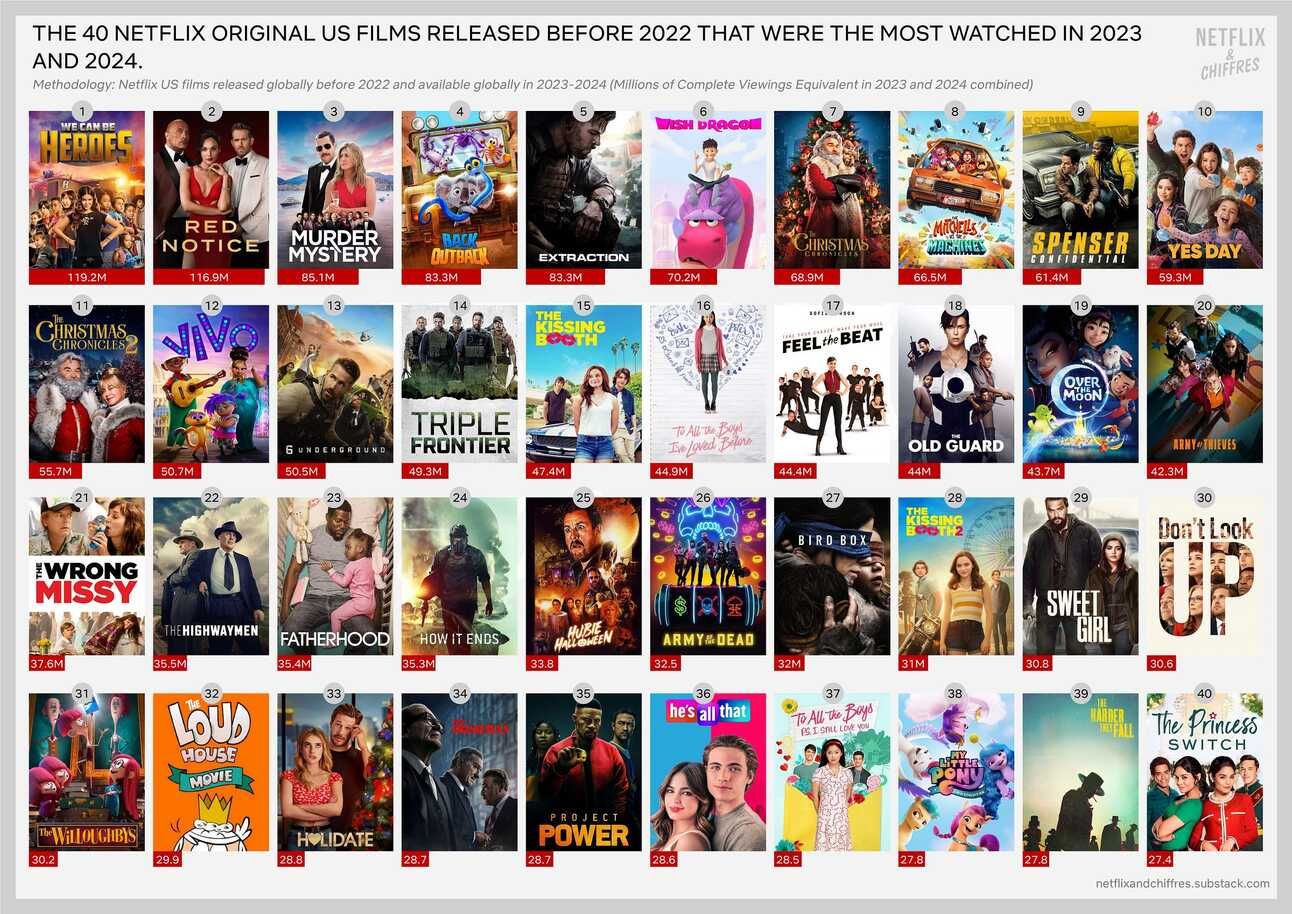
Several major categories emerge in this Top 40 ranking of the most-watched American Netflix films released before 2022 during the 2023–2024 period:
Animated films for children. There are eight in the Top 40, which shouldn’t surprise anyone given how animation on streaming services has become the new babysitter. We see the same trend on Disney+ in the Nielsen rankings, so it makes sense that Netflix’s animated films also show strong long-term performance.
Live-action kids' films. The same logic applies here, but it’s surprising to see We Can Be Heroes by Robert Rodriguez take the top spot as the most-watched American Netflix film from before 2022 in the 2023–2024 period, with nearly 120 million CVEs—an enormous number.
Romance (teen and adult). Netflix is often credited with reviving the genre, and this ranking confirms its ongoing strength. Eight romance films made the Top 40, including two from The Kissing Booth series and two from To All the Boys….
Action films starring major actors. Put Dwayne Johnson, Chris Hemsworth, Mark Wahlberg, Ryan Reynolds, Ben Affleck, Oscar Isaac, Charlize Theron, or Jamie Foxx in an action movie, and you have a long-term hit.
Films that have been or are in Netflix’s all-time Top 10. One of the most interesting observations is that a strong debut often translates into long-term success. Red Notice, Bird Box, We Can Be Heroes, and Don’t Look Up all rank among Netflix’s all-time Top 10, meaning they had one of the biggest 91-day debuts ever. But they also continue to perform well years later, especially Red Notice, suggesting that audiences don’t necessarily grow tired of rewatching blockbuster hits. Given Netflix’s 300 million paying subscribers, there’s always a new audience discovering them. Red Notice had 230 million CVEs in its first three months (through early February 2022), then 61.9 million in 2023 and 55 million in 2024. In total, it has likely surpassed 400 million CVEs. Not bad for a film that was widely panned by critics.
Prestige films. Martin Scorsese’s The Irishman continues to rack up views years after its release. The Harder They Fall is another unexpected prestige entry in the Top 40. But these are exceptions rather than the rule, as prestige films generally rank near the bottom.
Unclassifiable surprises. Who would have predicted that the comedy The Wrong Missy or Feel the Beat would rank so high? Certainly not me. Same goes for Army of Thieves having a better hold than Army of the Dead, the original film in that universe.
What factors reignite the viewership of a film released years ago?
As I mentioned, nearly half of the films in my dataset have experienced at least one semester of growth compared to the previous one, showing that for a number of films, this long tail can be "reactivated" through more or less clear factors.
Seasonality.

Christmas movies perform much better in the second half of the year than in the first, which is completely normal. Take the particularly striking example of The Christmas Chronicles by Chris Columbus:
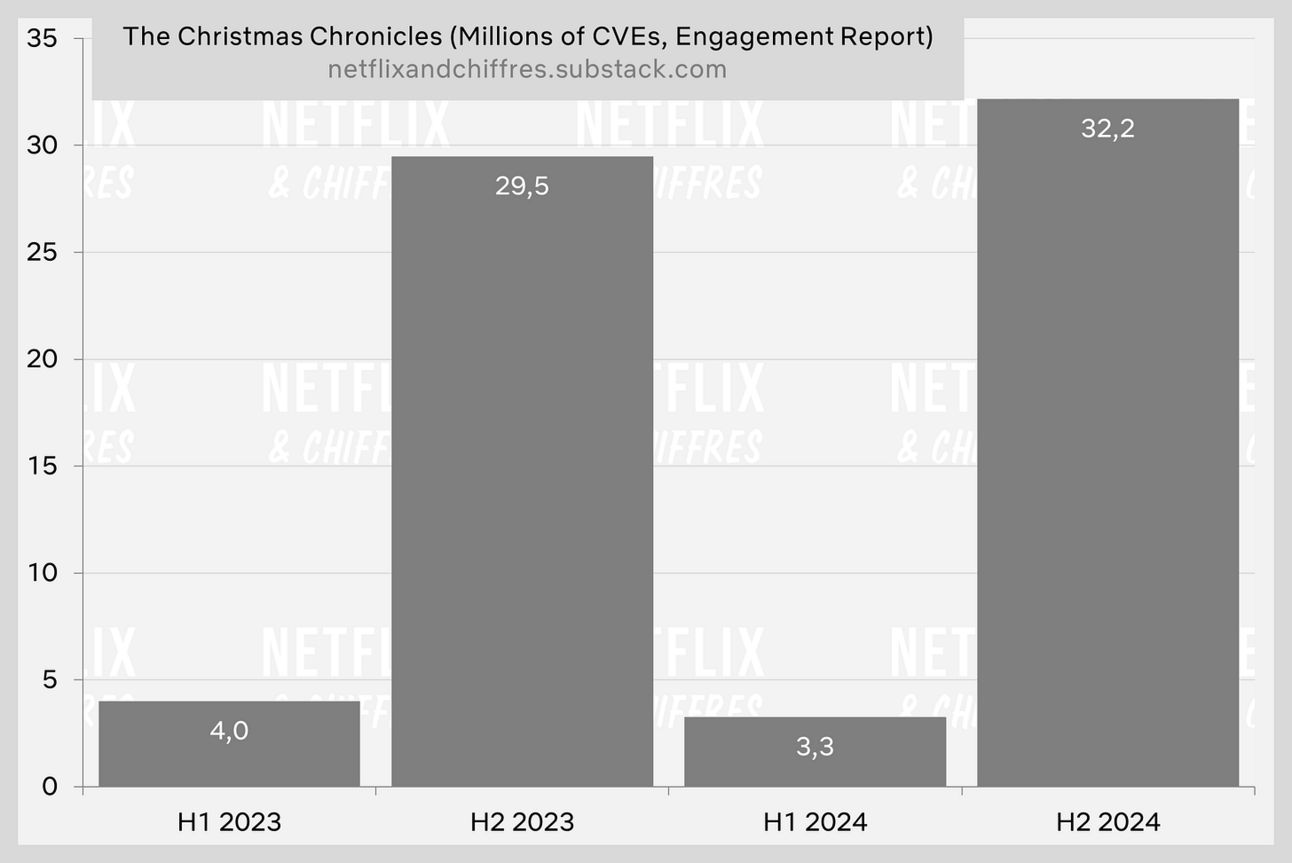
Halloween also boosts horror films such as the Fear Street trilogy or films with Halloween in the title during the second half of the year, such as Hubie Halloween with Adam Sandler, which always gain viewership in the second semester compared to the first.
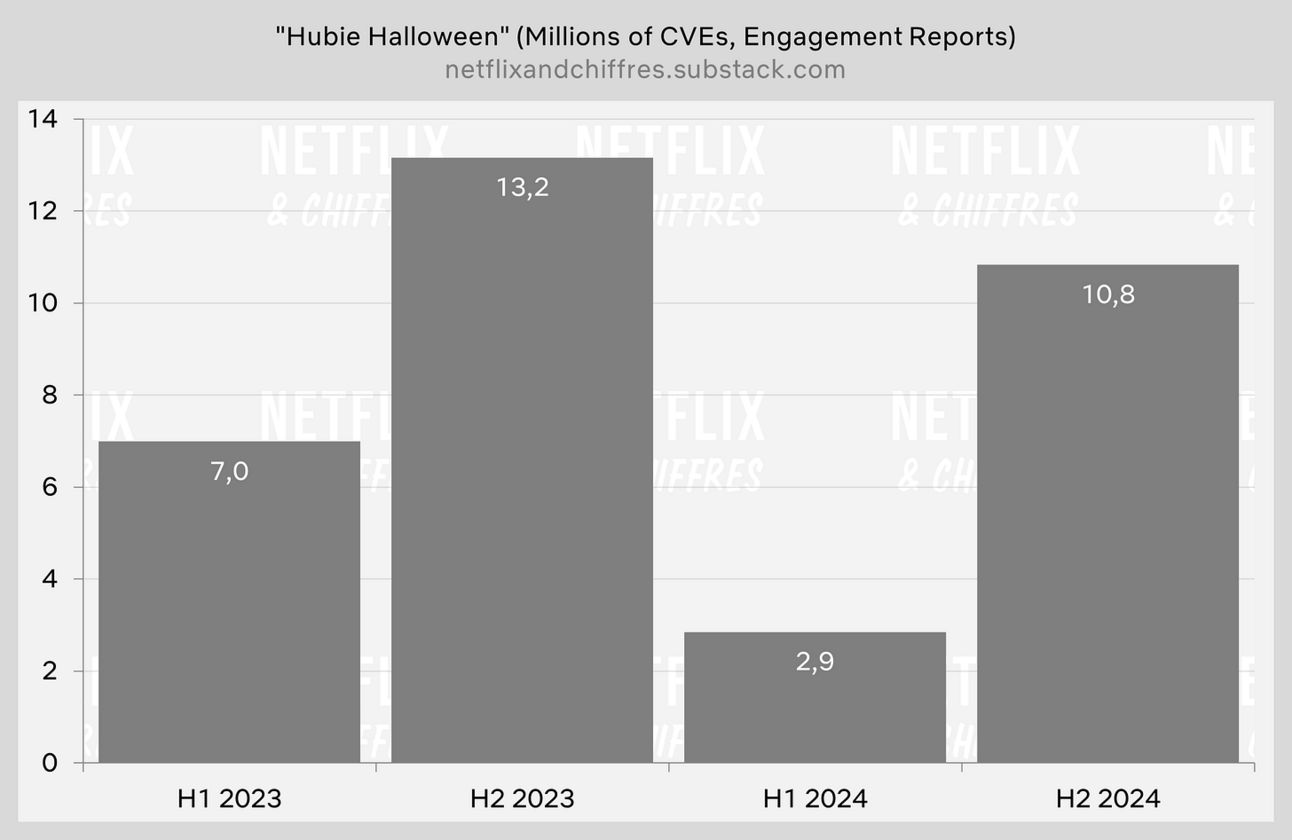
Valentine’s Day in the first half of the year also helps romantic comedies to some extent, but it’s less impactful than the Christmas season for Christmas films.
Releasing a sequel.

Releasing a sequel is still the best way to reignite the viewership of a film losing momentum. We have a few examples of this, such as Murder Mystery and Extraction. So, let’s play my favorite (and easy) game: in the following chart, can you spot the release semester of the Extraction sequel?
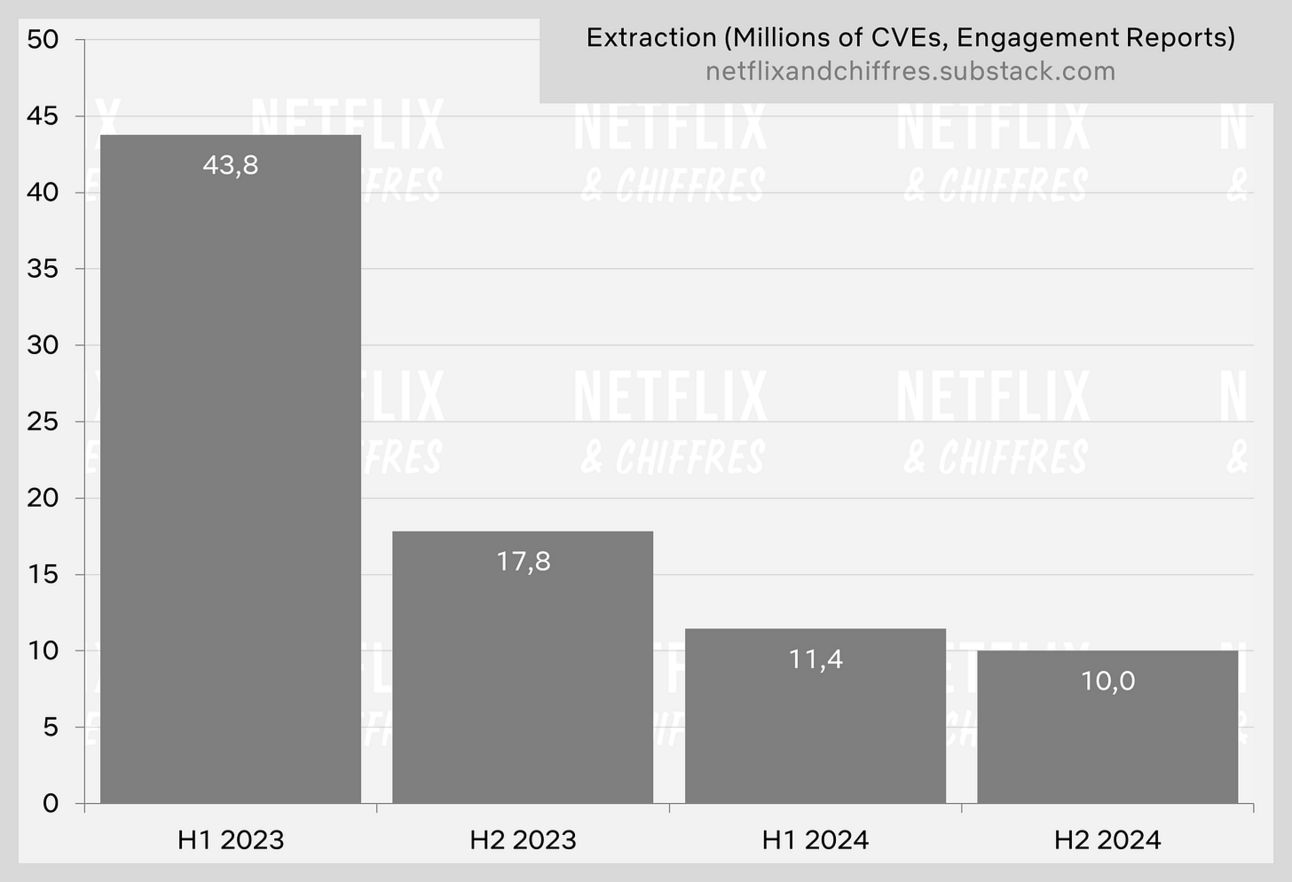
We can also categorize spin-offs in this context, taking as an example the impact of the release of the series XO, Kitty in the first half of 2023 on the viewership of To All the Boys I’ve Loved Before. However, I find it a bit harder to explain the increase throughout 2024.
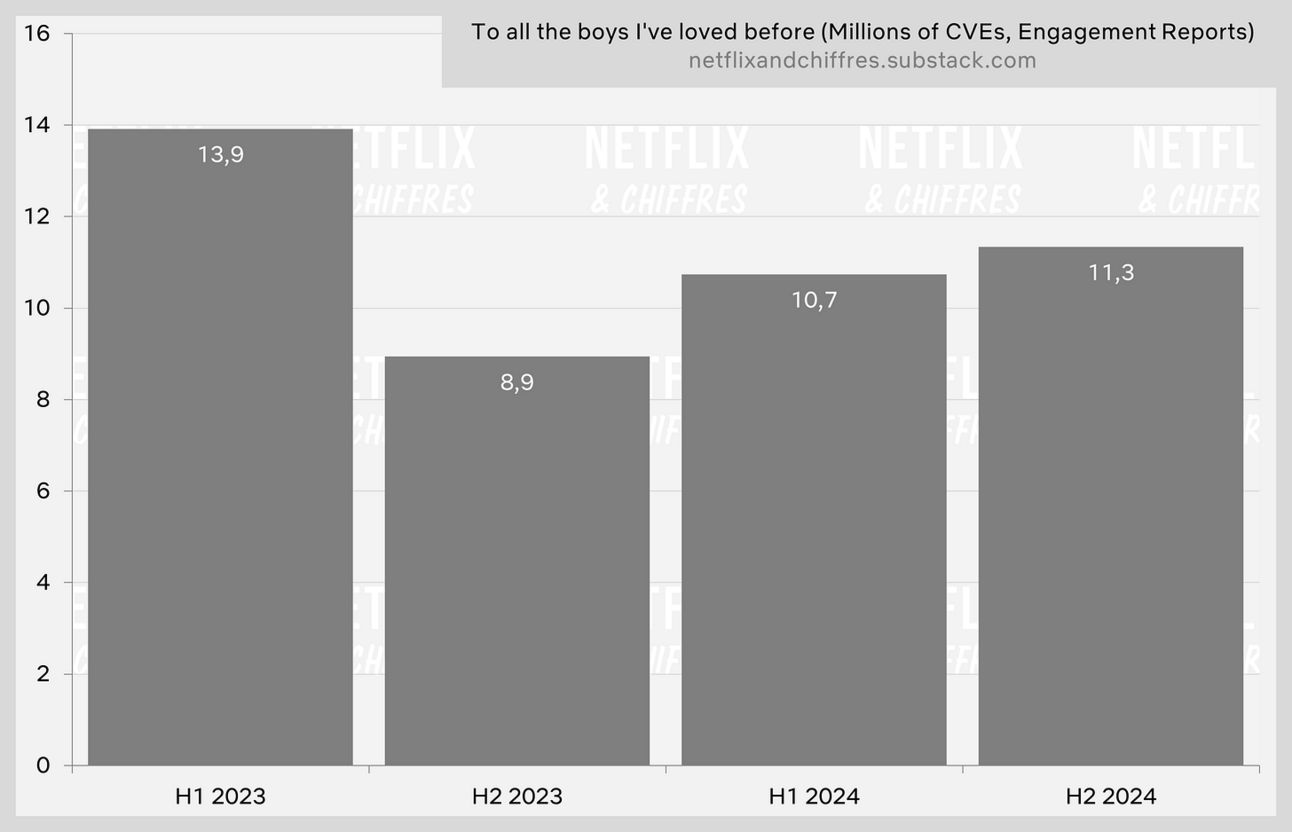
Releasing a different and successful film with the same lead actor.

Millie Bobby Brown is truly the perfect example of a Netflix star, and when her film Damsel performed well in March 2024, this success spilled over to her other films where she leads the cast, such as Enola Holmes, which almost doubled its viewership from one semester to the next. It’s fair to assume that the release last week of The Electric State will do just that as well for Enola Holmes and Damsel.
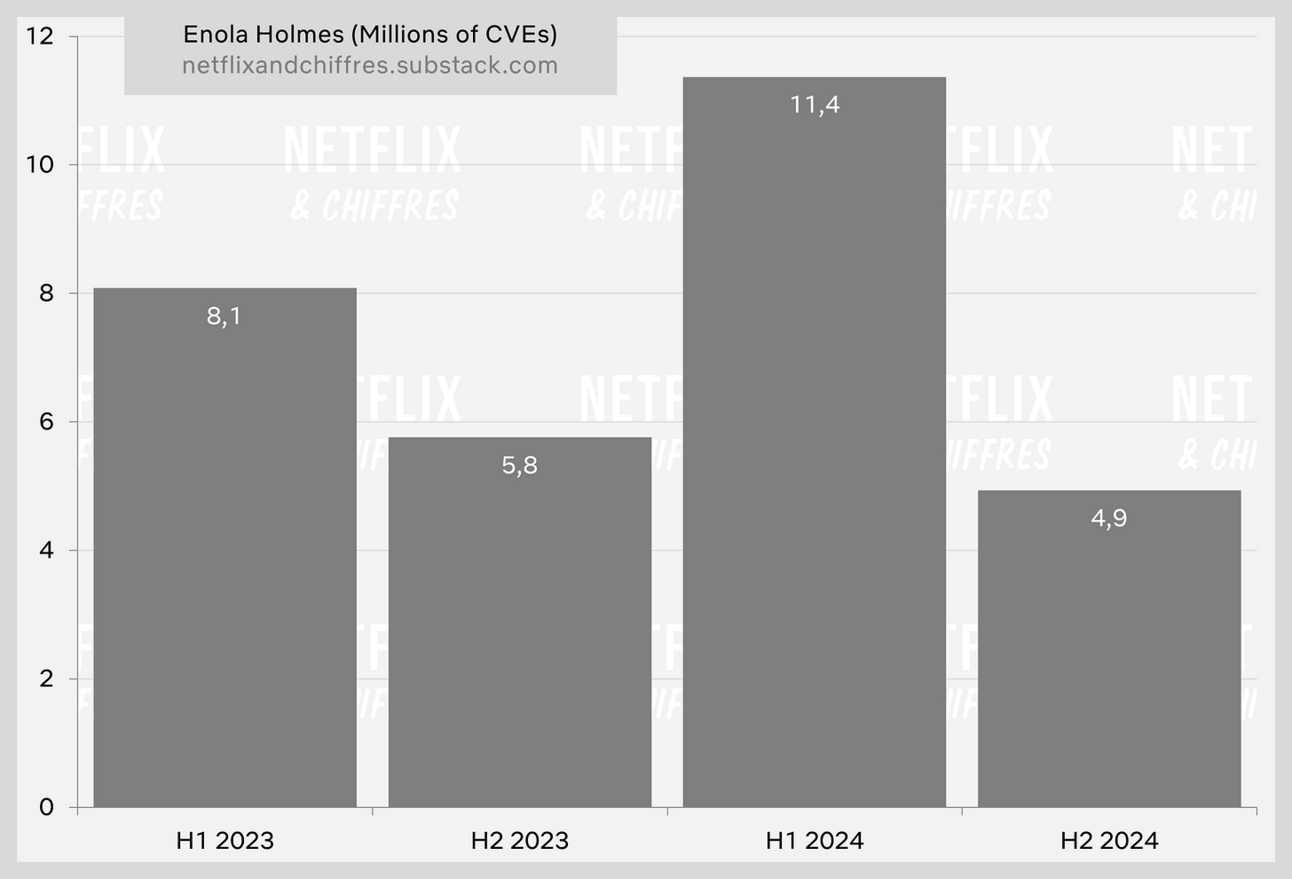
But Millie Bobby Brown is not the only one with that kind of pull. The same can be said for Adam Sandler and others on Netflix. Another example of this is Glen Powell, whose film with Sydney Sweeney, Anyone But You, had a small box office success in late 2023 and early 2024 before its release on Netflix in the U.S. in the first half of 2024. He had previously starred in Set It Up, another romantic comedy for Netflix years earlier, and boom, the film saw a resurgence in the first half of 2024.
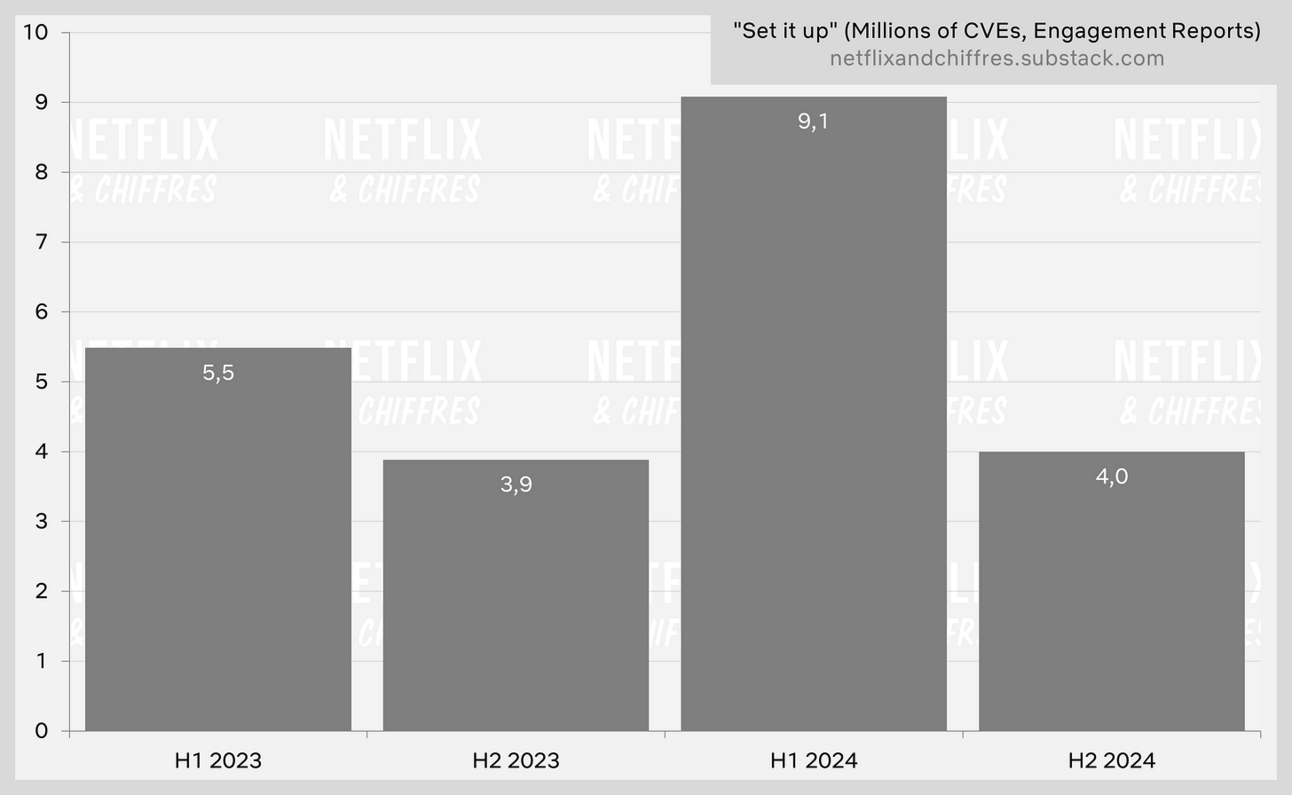
What’s going on in the wide world outside of Netflix.

When JD Vance was chosen by Donald Trump to be his running mate, the viewership of Hillbilly Elegy, the Netflix film adapted from his book, also skyrocketed, with a peak in the second half of 2024 during the U.S. presidential election. Certainly, it’s a very specific case, but it’s quite notable here.

The algorithm doing its own thing.

And finally, there are increases that are hard to explain. In my weekly analyses of the Netflix Top 10, it’s not uncommon to see films that were released months or even years earlier pop up in the Top 10 (usually in January, as if the algorithm switches to greatest hits of the past year mode). Successes of films on the service lead to others through recommendations during the end credits, and some films thus have quite unusual trajectories. I can cite examples like How It Ends or The Highwaymen, which exploded in viewership during a semester without a clear reason, only to drop off just as quickly.
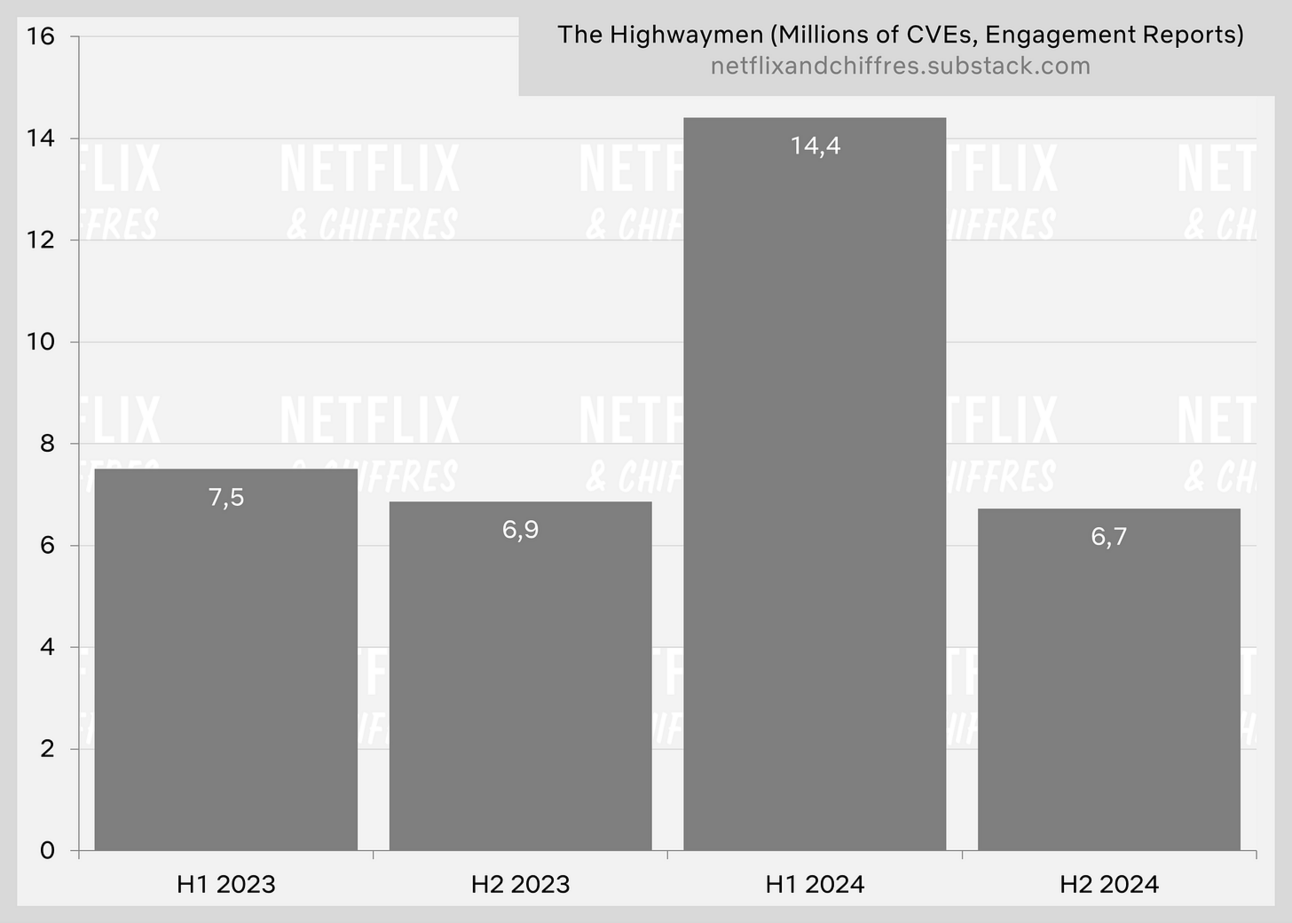
How many viewings does it take to say that a film is no longer "watched"?
When we say that no one is watching a film anymore, that it has sunk, body and soul, into a catalog that makes it invisible, where do we draw the line? 10 viewings per day? 100? 1,000? 10,000? That’s the real question in the end. To try and answer it, here is the list of the 276 films used for the basis of this article and their total number of CVEs for the years 2023 and 2024.

The first film on the list, We Can Be Heroes, was watched on average the equivalent of 163,511 times per day for the last two full years. The last film on the list to have been present in the Engagement Reports for the last four semesters, always on the brink of being excluded and becoming part of the 1% of the least-watched programs on Netflix, XOXO released in 2016, was watched on average the equivalent of 447 times per day for the last two full years. That’s the equivalent of 18 viewings per hour every day for two years straight more than 7 years after its release.
Is that a lot, especially for a film released several years ago? The problem is that we have no way to compare it to anything else. How many times is a particular film rented on VOD, bought on DVD, or watched on TV each day on average over a given period worldwide? No idea. The Engagement Reports give us this insight, but like many of the numbers provided by Netflix, we don’t have comparison points that would allow us to put them into perspective outside of Netflix. So, it’s a subjective line that we need to draw.
Personally, if a film I had released years earlier was still being watched nearly 500 times a day on average over the past two years, I think I’d be happy with that, but you’re free to disagree.
Conclusion
When we talk about a streaming catalog, especially on Netflix, the image that always comes up is that of an ocean of programs, with an unfathomable depth, where films sink as soon as they are launched. But this isn't entirely true, as we've seen here.
Each film release creates a wave of viewings that continues over time, more or less strongly depending on its initial impact, that can be reactivated by several factors, some predictable and others more mysterious. But if there is a decline, it is not systematic and certainly not immediate. Like a wave, it gradually diminishes—not to sink, but to become part of the ocean itself, waiting for a ripple that will make it bigger again.
That’s it for today, see you in a couple of days for a new analysis on the latest Netflix weekly Top 10. Feel free to share that study if you liked it!





